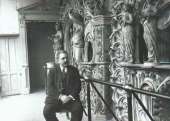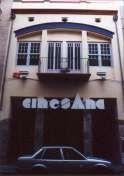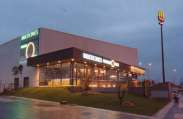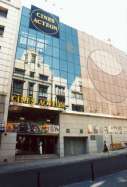The cinema was introduced into Spain in May 1896 by Alexandre Promio, an agent of the Lumières who had arrived the month before. The programme he presented contained titles shown in Paris on 28 December 1895 and was given in the Hotel de Rusia, 34, Carrera de San Jerónimo, Madrid. This was the first screening for which admission was charged (at one peseta) and it ran continuously from 10 a.m. The date was 14 May, although there had been a private screening for the press the day before, May 13. Both dates are found in official records of the early cinema in Spain, although the one conventionally marked as the anniversary of the first public and commercial screening is May 14.
| Year |
|
|
| 1950* 1951 1952 1953 1954 1955 1956 1957 1958 1959 1960 1961 1962 1963 1964 1965 1966 1967 1968 1969 |
|
|
| * Source: M. Gyory and G. Glas, Statistics of film industry in Europe, Bruxelles 1992 and MEDIA Salles, European Cinema Yearbook 1994, Milano 1994. | ||
 Among
the first spectators at one of Promio's shows in Madrid were Eduardo Jimeno
Peromarta and his son Eduardo Jimeno Correas, Aragonese showmen and the
proprietors of a large Travelling Panoramic Exhibition, with which they
toured throughout Spain. They also ran a permanent waxworks booth in Bilbao's
Glorieta square, together with a miniature theatre given the high-sounding
name of the Salon Meravillas. Dazzled by the possibilities of the
new invention, the Jimenos were keen to buy one for their show. As this
was impossible in Madrid, they travelled to Paris and bought a model by
Vernée which turned out to be a crude imitation of the Lumières'
design; with this they attempted to give screenings in various provincial
towns, but the tour was a complete fiasco. Following this unfortunate experience
the elder Jimeno made the trip to the Lumières' own factory in Lyon
and purchased a genuine device.
Among
the first spectators at one of Promio's shows in Madrid were Eduardo Jimeno
Peromarta and his son Eduardo Jimeno Correas, Aragonese showmen and the
proprietors of a large Travelling Panoramic Exhibition, with which they
toured throughout Spain. They also ran a permanent waxworks booth in Bilbao's
Glorieta square, together with a miniature theatre given the high-sounding
name of the Salon Meravillas. Dazzled by the possibilities of the
new invention, the Jimenos were keen to buy one for their show. As this
was impossible in Madrid, they travelled to Paris and bought a model by
Vernée which turned out to be a crude imitation of the Lumières'
design; with this they attempted to give screenings in various provincial
towns, but the tour was a complete fiasco. Following this unfortunate experience
the elder Jimeno made the trip to the Lumières' own factory in Lyon
and purchased a genuine device.
 With
this they gave a first performance in Burgos before an audience of 200,
in September 1896. A few days later on 14 September came the first screening
in Zaragoza; on 17 September it was the turn of Seville and on the 5 October
of Corunna. The first screening in Barcelona was held on 15 December, in
the Napoleon photography studio in Rambla de Santa Mónica.
With
this they gave a first performance in Burgos before an audience of 200,
in September 1896. A few days later on 14 September came the first screening
in Zaragoza; on 17 September it was the turn of Seville and on the 5 October
of Corunna. The first screening in Barcelona was held on 15 December, in
the Napoleon photography studio in Rambla de Santa Mónica.
The Jimenos went on putting on shows in their fairground booth in Zaragoza. To provide a crowd-pulling supplementary feature to their usual programme, on 11 October Eduardo Jimeno Correas shot what is officially recognized as Spain's first film, a reportage of the "Exit from the Midday Mass in the Pilar Cathedral in Zaragoza". On the following Sunday, 18 October, he filmed the same sequence again. The film was shot with the same device that projected it some hours afterward, following a rushed development process.
 After
returning to Madrid, they used their Theatre or Salon Meravillas
as the first permanent exhibition site in Spain, using it from then on
entirely for screenings. Initially called the Jimenographe, its name remained
unchanged until 1899 when it became the Palacio de Proyecciones Animadas
and was moved to the nearby address of 126, Calle de Fuencarral. This cinema
(soon joined by others which the Jimenos set up in different areas of the
city) operated until May 1912, when there was another move, this time to
number 142 (now 136) in the same street. The name was shortened to Proyecciones,
under which it continues in business in 1995, variously altered and with
modernized projection equipment.
After
returning to Madrid, they used their Theatre or Salon Meravillas
as the first permanent exhibition site in Spain, using it from then on
entirely for screenings. Initially called the Jimenographe, its name remained
unchanged until 1899 when it became the Palacio de Proyecciones Animadas
and was moved to the nearby address of 126, Calle de Fuencarral. This cinema
(soon joined by others which the Jimenos set up in different areas of the
city) operated until May 1912, when there was another move, this time to
number 142 (now 136) in the same street. The name was shortened to Proyecciones,
under which it continues in business in 1995, variously altered and with
modernized projection equipment.
| Year |
|
|
| 1970* 1971 1972 1973 1974 1975 1976 1977 1978 1979 1980 1981 1982 1983 1984 1985 1986 1987 1988 1989 1990 1991 1992 1993 1994 |
|
|
| * Source: M. Gyory and G. Glas, Statistics of film industry in Europe, Bruxelles 1992 and MEDIA Salles, European Cinema Yearbook 1994, Milano 1994. | ||
 Early
screening programmes were put together with titles from the Lumière
catalogue, although they might include a few Spanish subjects shot by the
French technicians who toured the country for the purpose. The filmography
of the Jimenos began and ended with the "Exit from Midday Mass", but they
were immediately followed by the pioneers of a nascent film industry. There
were several prominent names in the process: Fructuoso Gelabert, who filmed
the Sans parish church congregation and workers leaving Spanish factories,
and who also shot a narrative subject on a bar-room brawl, "Riña
en un café"; Segundo de Chomón, pioneering genius of Spanish
cinema, who in a long career spent mostly in France and Italy shot 350
films and invented or perfected a number of techniques or devices that
became standard tools of production (animation, the camera-winder, travelling,
hand-colouring of prints, etc.); Antonio Cuenta, documentarist; Alberto
Marro and Ricardo Baños, who founded the first major production
studio, Hispano Films. Barcelona led the way in cinema activities, culminating
in 1917 with the première of "The Life of Christopher Columbus and
the Discovery of America".
Early
screening programmes were put together with titles from the Lumière
catalogue, although they might include a few Spanish subjects shot by the
French technicians who toured the country for the purpose. The filmography
of the Jimenos began and ended with the "Exit from Midday Mass", but they
were immediately followed by the pioneers of a nascent film industry. There
were several prominent names in the process: Fructuoso Gelabert, who filmed
the Sans parish church congregation and workers leaving Spanish factories,
and who also shot a narrative subject on a bar-room brawl, "Riña
en un café"; Segundo de Chomón, pioneering genius of Spanish
cinema, who in a long career spent mostly in France and Italy shot 350
films and invented or perfected a number of techniques or devices that
became standard tools of production (animation, the camera-winder, travelling,
hand-colouring of prints, etc.); Antonio Cuenta, documentarist; Alberto
Marro and Ricardo Baños, who founded the first major production
studio, Hispano Films. Barcelona led the way in cinema activities, culminating
in 1917 with the première of "The Life of Christopher Columbus and
the Discovery of America".
Consolidation for filmmaking in Madrid came with Patria Films, founded in 1915 by Julio Rousset. Even the Nobel Prize-winning dramatist Jacinto Benavente was involved in production, as well as directing and providing scripts. 1915 also saw the foundation of the Mutua de Defensa Cinematográfica Española, aimed at solving the conflicts within the fledgling industry.
Il cinema fu introdotto in Spagna nel maggio 1896 da Alexandre Promio, un agente dei Fratelli Lumière, giunto a Madrid nel mese di aprile. Il programma che egli propose conteneva film già proiettati il 28 dicembre 1895 a Parigi e fu presentato al 34 della Carrera de San Jerónimo a Madrid. Questa fu la prima proiezione per la quale il pubblico dovette pagare il biglietto (una peseta). Continuò, senza interruzioni, a partire dalle 10 del mattino. Era il 14 maggio; il giorno prima era già stata organizzata una proiezione privata accessibile solo alla stampa. Entrambe le date sono conservate negli annali della storia del cinema in Spagna, sebbene il giorno convenzionalmente ritenuto l'anniversario della prima proiezione pubblica e commerciale sia il 14 maggio.
| Anno |
|
|
| 1950* 1951 1952 1953 1954 1955 1956 1957 1958 1959 1960 1961 1962 1963 1964 1965 1966 1967 1968 1969 |
|
|
| * Fonte: M. Gyory e G. Glas, Statistics of film industry in Europe, Bruxelles 1992 e MEDIA Salles, European Cinema Yearbook 1994, Milano 1994. | ||
 Tra
i primi spettatori che presero parte ad uno degli spettacoli di Promio
a Madrid figuravano anche Eduardo Jimeno Peromarta e suo figlio Eduardo
Jimeno Correas, impresari aragonesi e proprietari di una fiera viaggiante
"Exposición Panorámica Itinerante", con la quale percorrevano
l'intera Spagna. Essi gestivano anche un'esposizione di statue di cera
presso la piazza Glorieta in Bilbao, insieme ad un piccolo teatro cui era
stato dato un nome altisonante, il Salon Meravillas. Attirati dalle
possibilità offerte dalla nuova invenzione, gli Jimenos volevano
acquistarne un esemplare per il loro spettacolo. Dal momento che questo
era decisamente irrealizzabile a Madrid, si spinsero fino a Parigi dove
acquistarono un modello da Vernée; esso si presentò subito
come una grossolana imitazione di quello realizzato dai Lumière;
con questo strumento essi cercarono di proporre proiezioni in molte città
di provincia, ma il tour fu un totale fallimento. A seguito di questa sfortunata
esperienza, E. Jimeno Peromarta si recò presso lo stabilimento degli
stessi Lumière a Lione dove acquistò l'attrezzatura originale.
Tra
i primi spettatori che presero parte ad uno degli spettacoli di Promio
a Madrid figuravano anche Eduardo Jimeno Peromarta e suo figlio Eduardo
Jimeno Correas, impresari aragonesi e proprietari di una fiera viaggiante
"Exposición Panorámica Itinerante", con la quale percorrevano
l'intera Spagna. Essi gestivano anche un'esposizione di statue di cera
presso la piazza Glorieta in Bilbao, insieme ad un piccolo teatro cui era
stato dato un nome altisonante, il Salon Meravillas. Attirati dalle
possibilità offerte dalla nuova invenzione, gli Jimenos volevano
acquistarne un esemplare per il loro spettacolo. Dal momento che questo
era decisamente irrealizzabile a Madrid, si spinsero fino a Parigi dove
acquistarono un modello da Vernée; esso si presentò subito
come una grossolana imitazione di quello realizzato dai Lumière;
con questo strumento essi cercarono di proporre proiezioni in molte città
di provincia, ma il tour fu un totale fallimento. A seguito di questa sfortunata
esperienza, E. Jimeno Peromarta si recò presso lo stabilimento degli
stessi Lumière a Lione dove acquistò l'attrezzatura originale.
 Con
questa fu dato, nel settembre 1896, il primo spettacolo in Burgos, davanti
ad un pubblico di 200 persone. Alcuni giorni più tardi, il 14 settembre,
ebbe luogo la prima proiezione a Saragozza; il 17 settembre fu la volta
di Siviglia ed il 5 dicembre quella di Coruña. La prima proiezione
a Barcellona avvenne il 15 dicembre presso lo studio fotografico Napoleon
in Rambla de Santa Mónica. Gli Jimenos continuarono a dare spettacoli
nel padiglione della loro fiera di divertimento in Saragozza. Nell'intento
di proporre una novità rispetto al programma abituale, l'11 ottobre,
Eduardo Jimeno Correas girò quello che viene ufficialmente riconosciuto
come il primo film spagnolo, ovvero SALIDA DE MISA DE DOCE DAL PILAR DE
ZARAGOZA. La domenica seguente, il 18 ottobre, egli filmò di nuovo
la stessa scena. Il film fu girato con lo stesso apparecchio che lo proiettò
qualche ora più tardi. Per lo sviluppo fu utilizzato un procedimento
rapido.
Con
questa fu dato, nel settembre 1896, il primo spettacolo in Burgos, davanti
ad un pubblico di 200 persone. Alcuni giorni più tardi, il 14 settembre,
ebbe luogo la prima proiezione a Saragozza; il 17 settembre fu la volta
di Siviglia ed il 5 dicembre quella di Coruña. La prima proiezione
a Barcellona avvenne il 15 dicembre presso lo studio fotografico Napoleon
in Rambla de Santa Mónica. Gli Jimenos continuarono a dare spettacoli
nel padiglione della loro fiera di divertimento in Saragozza. Nell'intento
di proporre una novità rispetto al programma abituale, l'11 ottobre,
Eduardo Jimeno Correas girò quello che viene ufficialmente riconosciuto
come il primo film spagnolo, ovvero SALIDA DE MISA DE DOCE DAL PILAR DE
ZARAGOZA. La domenica seguente, il 18 ottobre, egli filmò di nuovo
la stessa scena. Il film fu girato con lo stesso apparecchio che lo proiettò
qualche ora più tardi. Per lo sviluppo fu utilizzato un procedimento
rapido.
| Anno |
|
|
| 1970* 1971 1972 1973 1974 1975 1976 1977 1978 1979 1980 1981 1982 1983 1984 1985 1986 1987 1988 1989 1990 1991 1992 1993 1994 |
|
|
| * Fonte: M. Gyory e G. Glas, Statistics of film industry in Europe, Bruxelles 1992 e MEDIA Salles, European Cinema Yearbook 1994, Milano 1994. | ||
 usufruendone,
da quel momento in poi, esclusivamente per le proiezioni. Inizialmente
denominata Jimenographe, vide cambiare il suo nome solo nel 1899, quando
divenne il Palacio de Proyecciones Animadas e venne trasferito al numero
126 della vicina Calle de Fuencarral. Questa sala cinematografica (cui
se ne aggiunsero ben presto altre, installate dagli Jimenos in diverse
parti della Città) svolse la sua attività fino al maggio
del 1912, anno in cui ebbe luogo un ulteriore spostamento, questa volta
al numero 142 (l'attuale 136) della stessa via. Il nome venne abbreviato
in "Proyecciones". Con questa denominazione la sala continua tuttora ad
operare, più volte ristrutturata e dotata di moderni strumenti di
proiezione.
usufruendone,
da quel momento in poi, esclusivamente per le proiezioni. Inizialmente
denominata Jimenographe, vide cambiare il suo nome solo nel 1899, quando
divenne il Palacio de Proyecciones Animadas e venne trasferito al numero
126 della vicina Calle de Fuencarral. Questa sala cinematografica (cui
se ne aggiunsero ben presto altre, installate dagli Jimenos in diverse
parti della Città) svolse la sua attività fino al maggio
del 1912, anno in cui ebbe luogo un ulteriore spostamento, questa volta
al numero 142 (l'attuale 136) della stessa via. Il nome venne abbreviato
in "Proyecciones". Con questa denominazione la sala continua tuttora ad
operare, più volte ristrutturata e dotata di moderni strumenti di
proiezione.
Nel 1907 un quotidiano madrileno contava almeno 26 sale cinematografiche nella sola capitale. La più vecchia di queste, il Palacio de Proyecciones, diede origine ad una proliferazione di sale cinematografiche in tutte le maggiori città durante i primi anni del secolo, comparabile solo a quella che avvenne all'indomani della Guerra Civile.
 I
primi programmi di proiezione vennero organizzati con titoli tratti dal
catalogo Lumière, sebbene essi includessero solo pochi soggetti
spagnoli filmati dagli operatori francesi che, a tale scopo, viaggiavano
per l'intero paese. La produzione degli Jimenos cominciò e terminò
con SALIDA DE MISA. Ad essi fecero seguito i pionieri dell'industria cinematografica
nascente. In questa fase figurano molti nomi di spicco: Fructuoso Gelabert,
che riprese l'uscita dei fedeli dalla chiesa parrocchiale di Sans e dei
lavoratori della "España Industrial" e che girò anche un
soggetto narrativo su una rissa avvenuta presso un bar, "Riña en
un café"; Segundo de Chómon, geniale pioniere del cinema
spagnolo che, durante la sua lunga carriera trascorsa prevalentemente in
Francia ed in Italia, girò 350 film ed inventò, o perfezionò,
un certo numero di tecniche e di apparecchiature per la produzione che
divennero, ben presto, largamente diffuse (animazione, strumenti per il
riavvolgimento della pellicola, riprese in movimento, colorazione manuale
delle pellicole ecc.); Antonio Cuenta, documentarista; Alberto Marro e
Ricardo Baños, che fondarono la prima importante casa di produzione,
l'Hispano Films. Barcellona aprì la strada nelle attività
cinematografiche, che culminarono nel 1917 con la prima proiezione de LA
VIDA DE CRISTÓBAL COLÓN Y SU DESCUBRIMIENTO DE AMERICA. Il
consolidamento della produzione cinematografica a Madrid si ebbe con la
Patria Films, fondata nel 1915 da Julio Rousset. Perfino il drammaturgo
Jacinto Benavente, vincitore del premio Nobel, fu coinvolto nella produzione
così come nella regia e nella sceneggiatura. Il 1915 vide anche
la fondazione della Mutua de Defensa Cinematográfica Española,
intesa a risolvere i conflitti nell'ambito dell'industria ancora nascente.
I
primi programmi di proiezione vennero organizzati con titoli tratti dal
catalogo Lumière, sebbene essi includessero solo pochi soggetti
spagnoli filmati dagli operatori francesi che, a tale scopo, viaggiavano
per l'intero paese. La produzione degli Jimenos cominciò e terminò
con SALIDA DE MISA. Ad essi fecero seguito i pionieri dell'industria cinematografica
nascente. In questa fase figurano molti nomi di spicco: Fructuoso Gelabert,
che riprese l'uscita dei fedeli dalla chiesa parrocchiale di Sans e dei
lavoratori della "España Industrial" e che girò anche un
soggetto narrativo su una rissa avvenuta presso un bar, "Riña en
un café"; Segundo de Chómon, geniale pioniere del cinema
spagnolo che, durante la sua lunga carriera trascorsa prevalentemente in
Francia ed in Italia, girò 350 film ed inventò, o perfezionò,
un certo numero di tecniche e di apparecchiature per la produzione che
divennero, ben presto, largamente diffuse (animazione, strumenti per il
riavvolgimento della pellicola, riprese in movimento, colorazione manuale
delle pellicole ecc.); Antonio Cuenta, documentarista; Alberto Marro e
Ricardo Baños, che fondarono la prima importante casa di produzione,
l'Hispano Films. Barcellona aprì la strada nelle attività
cinematografiche, che culminarono nel 1917 con la prima proiezione de LA
VIDA DE CRISTÓBAL COLÓN Y SU DESCUBRIMIENTO DE AMERICA. Il
consolidamento della produzione cinematografica a Madrid si ebbe con la
Patria Films, fondata nel 1915 da Julio Rousset. Perfino il drammaturgo
Jacinto Benavente, vincitore del premio Nobel, fu coinvolto nella produzione
così come nella regia e nella sceneggiatura. Il 1915 vide anche
la fondazione della Mutua de Defensa Cinematográfica Española,
intesa a risolvere i conflitti nell'ambito dell'industria ancora nascente.